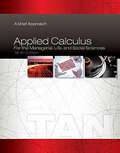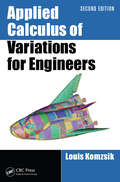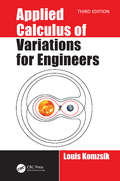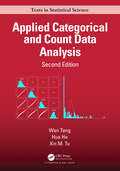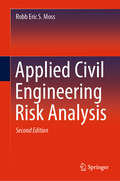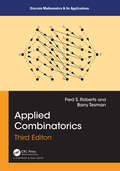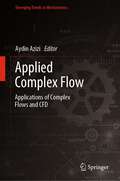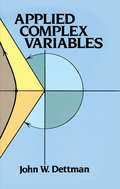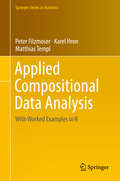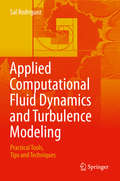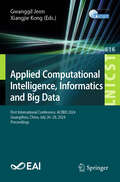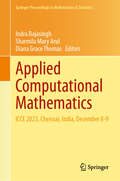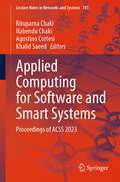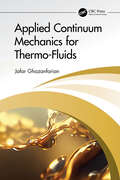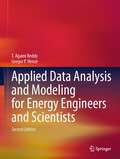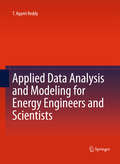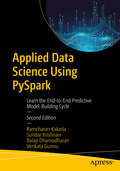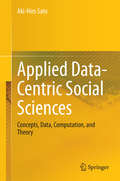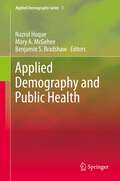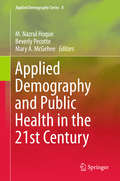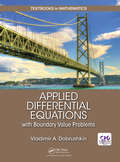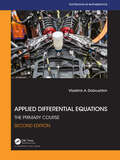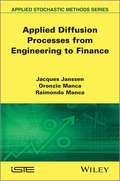- Table View
- List View
Applied Calculus for the Managerial, Life, and Social Sciences: A Brief Approach
by Soo TanAPPLIED CALCULUS FOR THE MANAGERIAL, LIFE, AND SOCIAL SCIENCES: A BRIEF APPROACH, Tenth Edition balances modern applications, solid pedagogy, and the latest technology to engage students and keep them motivated in the course. Suitable for majors and non-majors alike, the text uses an intuitive approach that teaches concepts through examples drawn from real-life situations from students' fields of interest. In addition, insightful Portfolios highlight the careers of real people and discuss how they incorporate math into their daily professional activities. Numerous exercises, including a Diagnostic Test, ensure that students have a concrete understanding of concepts before advancing to the next topic. The text's pedagogical features coupled with an exciting array of supplements equip students with the tools they need to make the most of their study time and to succeed in the course.
Applied Calculus of Variations for Engineers
by Louis KomzsikThe purpose of the calculus of variations is to find optimal solutions to engineering problems whose optimum may be a certain quantity, shape, or function. Applied Calculus of Variations for Engineers addresses this important mathematical area applicable to many engineering disciplines. Its unique, application-oriented approach sets it apart from the theoretical treatises of most texts, as it is aimed at enhancing the engineer’s understanding of the topic.This Second Edition text:Contains new chapters discussing analytic solutions of variational problems and Lagrange-Hamilton equations of motion in depthProvides new sections detailing the boundary integral and finite element methods and their calculation techniquesIncludes enlightening new examples, such as the compression of a beam, the optimal cross section of beam under bending force, the solution of Laplace’s equation, and Poisson’s equation with various methodsApplied Calculus of Variations for Engineers, Second Edition extends the collection of techniques aiding the engineer in the application of the concepts of the calculus of variations.
Applied Calculus of Variations for Engineers, Third edition
by Louis KomzsikCalculus of variations has a long history. Its fundamentals were laid down by icons of mathematics like Euler and Lagrange. It was once heralded as the panacea for all engineering optimization problems by suggesting that allone needed to do was to state a variational problem, apply the appropriate Euler-Lagrange equation and solve the resulting differential equation. This, as most all encompassing solutions, turned out to be not always true and the resulting differential equations are not necessarily easy to solve. On the other hand, many of the differential equations commonly used in various fields of engineering are derived from a variational problem. Hence it is an extremely important topic justifying the new edition of this book. This third edition extends the focus of the book to academia and supports both variational calculus and mathematical modeling classes. The newly added sections, extended explanations, numerous examples and exercises aid the students in learning, the professors in teaching, and the engineers in applying variational concepts.
Applied Categorical and Count Data Analysis (Chapman & Hall/CRC Texts in Statistical Science)
by Wan Tang Hua He Xin M. TuDeveloped from the authors’ graduate-level biostatistics course, Applied Categorical and Count Data Analysis, Second Edition explains how to perform the statistical analysis of discrete data, including categorical and count outcomes. The authors have been teaching categorical data analysis courses at the University of Rochester and Tulane University for more than a decade. This book embodies their decade-long experience and insight in teaching and applying statistical models for categorical and count data. The authors describe the basic ideas underlying each concept, model, and approach to give readers a good grasp of the fundamentals of the methodology without relying on rigorous mathematical arguments. The second edition covers classic concepts and popular topics, such as contingency tables, logistic regression models, and Poisson regression models, along with modern areas that include models for zero-modified count outcomes, parametric and semiparametric longitudinal data analysis, reliability analysis, and methods for dealing with missing values. As in the first edition, R, SAS, SPSS, and Stata programming codes are provided for all the examples, enabling readers to immediately experiment with the data in the examples and even adapt or extend the codes to fit data from their own studies. Designed for a one-semester course for graduate and senior undergraduate students in biostatistics, this self-contained text is also suitable as a self-learning guide for biomedical and psychosocial researchers. It will help readers analyze data with discrete variables in a wide range of biomedical and psychosocial research fields. Features: -Describes the basic ideas underlying each concept and model. -Includes R, SAS, SPSS and Stata programming codes for all the examples -Features significantly expanded Chapters 4, 5, and 8 (Chapters 4-6, and 9 in the second edition. -Expands discussion for subtle issues in longitudinal and clustered data analysis such as time varying covariates and comparison of generalized linear mixed-effect models with GEE.
Applied Choice Analysis
by William H. Greene David A. Hensher John M. RoseAlmost without exception, everything human beings undertake involves a choice. In recent years there has been a growing interest in the development and application of quantitative statistical methods to study choices made by individuals with the purpose of gaining a better understanding both of how choices are made and of forecasting future choice responses. In this primer the authors provide an unintimidating introduction to the main techniques of choice analysis and include detail on themes such as data collection and preparation, model estimation and interpretation and the design of choice experiments. A companion website to the book provides practice data sets and software to estimate the main discrete choice models such as multinomial logit, nested logit and mixed logit. This primer will be an invaluable resource to students as well as of immense value to consultants and professionals, researchers and anyone else interested in choice analysis and modelling.
Applied Choice Analysis
by William H. Greene David A. Hensher John M. Rose David A. Hensher John M. RoseIn recent years, there has been growing interest in the development and application of quantitative statistical methods to study choices made by individuals. This primer provides an introduction to the main techniques of choice analysis and also includes details on data collection and preparation, model estimation and interpretation and the design of choice experiments. A companion website offers practice data sets and software to apply modeling and data skills presented in the book.
Applied Civil Engineering Risk Analysis
by Robb Eric MossThis updated edition retains its introduction to applied fundamental statistics, probability, reliability, and decision theory as these pertain to problems in Civil Engineering. The new edition adds an expanded treatment of systems reliability, Bayesian methods, and spatial variabililty, along with additional example problems throughout. The book provides readers with the tools needed to determine the probability of failure, and when multiplied by the consequences of failure, illustrates how to assess the risk of civil engineering problems. Presenting methods for quantifying uncertainty that exists in engineering analysis and design, with an emphasis on fostering more accurate analysis and design, the text is ideal for students and practitioners of a range of civil engineering disciplines. Expands on the class-tested pedagogy from the first edition with more material and more examples;Broadens understanding with simulations coded both in Matlab and in R; Features new chapters on spatial variability and Bayesian methods;Emphasizes techniques for estimating the influence of uncertainty on the probability of failure
Applied Combinatorics, Third Edition (Discrete Mathematics and Its Applications)
by Barry Tesman Fred S. RobertsThe third edition of this popular text presents the tools of combinatorics for a first undergraduate course. After introducing fundamental counting rules, tools of graph theory and relations, the focus is on three basic problems of combinatorics: counting, existence, and optimization problems.
Applied Complex Flow: Applications of Complex Flows and CFD (Emerging Trends in Mechatronics)
by Aydin AziziThis book presents improved numerical techniques and applied computer-aided simulations as a part of emerging trends in mechatronics in all areas related to complex fluids, with particular focus on using a combination of modeling, theory, and simulation to study systems that are complex due to the rheology of fluids (i.e., ceramic pastes, polymer solutions and melts, colloidal suspensions, emulsions, foams, micro-/nanofluids, etc.) and multiphysics phenomena in which the interactions of various effects (thermal, chemical, electric, magnetic, or mechanical) lead to complex dynamics. The areas of applications span materials processing, manufacturing, and biology.
Applied Complex Variables (Dover Books on Mathematics)
by John W. DettmanAnalytic function theory is a traditional subject going back to Cauchy and Riemann in the 19th century. Once the exclusive province of advanced mathematics students, its applications have proven vital to today's physicists and engineers. In this highly regarded work, Professor John W. Dettman offers a clear, well-organized overview of the subject and various applications -- making the often-perplexing study of analytic functions of complex variables more accessible to a wider audience.The first half of Applied Complex Variables, designed for sequential study, is a step-by-step treatment of fundamentals, presenting superior coverage of concepts of complex analysis, including the complex number plane; functions and limits; the Cauchy-Riemann conditions for differentiability; Riemann surfaces; the definite integral; power series; meromorphic functions; and much more. The second half provides lucid exposition of five important applications of analytic function theory, each approachable independently of the others: potential theory; ordinary differential equations; Fourier transforms; Laplace transforms; and asymptotic expansions. Helpful exercises are included at the end of each topic in every chapter. The two-part structure of Applied Complex Variables affords the college instructor maximum classroom flexibility. Once fundamentals are mastered, applications can be studied in any sequence desired. Depending on how many are selected for study, Professor Dettman's impressive text is ideal for either a one- or two-semester course. And, of course, the ambitious student possessing a knowledge of basic calculus will find its straightforward approach rewarding to his independent study efforts.Applied Complex Variables is a cogent, well-written introduction to an important and exciting branch of advanced mathematics -- serving both the theoretical needs of the mathematics specialist and the applied math needs of the physicist and engineer. Students and teachers alike will welcome this timely, moderately priced reissue of a widely respected work.
Applied Compositional Data Analysis: With Worked Examples In R (Springer Series in Statistics)
by Peter Filzmoser Matthias Templ Karel HronThis book presents the statistical analysis of compositional data using the log-ratio approach. It includes a wide range of classical and robust statistical methods adapted for compositional data analysis, such as supervised and unsupervised methods like PCA, correlation analysis, classification and regression. In addition, it considers special data structures like high-dimensional compositions and compositional tables. The methodology introduced is also frequently compared to methods which ignore the specific nature of compositional data. It focuses on practical aspects of compositional data analysis rather than on detailed theoretical derivations, thus issues like graphical visualization and preprocessing (treatment of missing values, zeros, outliers and similar artifacts) form an important part of the book. Since it is primarily intended for researchers and students from applied fields like geochemistry, chemometrics, biology and natural sciences, economics, and social sciences, all the proposed methods are accompanied by worked-out examples in R using the package robCompositions.
Applied Computational Fluid Dynamics and Turbulence Modeling: Practical Tools, Tips and Techniques
by Sal RodriguezThis unique text provides engineering students and practicing professionals with a comprehensive set of practical, hands-on guidelines and dozens of step-by-step examples for performing state-of-the-art, reliable computational fluid dynamics (CFD) and turbulence modeling. Key CFD and turbulence programs are included as well. The text first reviews basic CFD theory, and then details advanced applied theories for estimating turbulence, including new algorithms created by the author. The book gives practical advice on selecting appropriate turbulence models and presents best CFD practices for modeling and generating reliable simulations. The author gathered and developed the book’s hundreds of tips, tricks, and examples over three decades of research and development at three national laboratories and at the University of New Mexico—many in print for the first time in this book. The book also places a strong emphasis on recent CFD and turbulence advancements found in the literature over the past five to 10 years. Readers can apply the author’s advice and insights whether using commercial or national laboratory software such as ANSYS Fluent, STAR-CCM, COMSOL, Flownex, SimScale, OpenFOAM, Fuego, KIVA, BIGHORN, or their own computational tools. Applied Computational Fluid Dynamics and Turbulence Modeling is a practical, complementary companion for academic CFD textbooks and senior project courses in mechanical, civil, chemical, and nuclear engineering; senior undergraduate and graduate CFD and turbulence modeling courses; and for professionals developing commercial and research applications.
Applied Computational Intelligence, Informatics and Big Data: First International Conference, ACIIBD 2024, Guangzhou, China, July 26–28, 2024, Proceedings (Lecture Notes of the Institute for Computer Sciences, Social Informatics and Telecommunications Engineering #616)
by Gwanggil Jeon Xiangjie KongThis book LNICST 616 constitutes the proceedings of the First International Conference on Applied Computational Intelligence, Informatics and Big Data, ACIIBD 2024, held in Guangzhou, China, during July 26–28, 2024. The 3 full papers and 15 shot papers were carefully reviewed and selected from 56 submissions. This Proceedings cover topics on Internet of Things, Information Communication Technology, Edge Computing, Mobile Computing, Neural Network, Intelligent Control System, Real-Time Information System, Intelligent Perception and many other cutting-edge fields and disciplines.
Applied Computational Mathematics: ICCE 2023, Chennai, India, December 8-9 (Springer Proceedings in Mathematics & Statistics #480)
by Indra Rajasingh Sharmila Mary Arul Diana Grace ThomasThis proceedings volume showcases high-quality original research papers presented at the International Conference on Computational Engineering (ICCE 2023), held in Chennai, India, from December 8-9, 2023 dedicated to advancing interdisciplinary research in the realm of mathematics and its pivotal role in Computer Engineering. Explore the dynamic field of Computational Engineering, where innovative computational techniques—such as computer simulations, mathematical modeling, and numerical analysis—are employed to tackle complex engineering challenges. By integrating principles from engineering, computer science, and applied mathematics, this collection illustrates how virtual prototypes enable engineers to analyze and optimize systems before physical testing, saving valuable time and resources. Featuring selected works from conference participants and outstanding contributions from external researchers, this book highlights the broad applications of Computational Engineering across civil, mechanical, aerospace, chemical, electrical engineering, and beyond. Dive into cutting-edge research that paves the way for future advancements in engineering practices.
Applied Computing for Software and Smart Systems: Proceedings of ACSS 2023 (Lecture Notes in Networks and Systems #781)
by Khalid Saeed Nabendu Chaki Agostino Cortesi Rituparna ChakiThis book features a collection of high-quality research papers presented at the 10th International Symposium on Applied Computing for Software and Smart systems (ACSS 2023), to be held during September 15–16, 2023, in Kolkata, India. The book presents innovative works by undergraduate, graduate students as well as Ph.D. scholars. The emphasis of the workshop is on software and smart systems and research outcomes on other relevant areas pertaining to advancement of computing.
Applied Continuum Mechanics for Thermo-Fluids
by Jafar GhazanfarianApplied Continuum Mechanics for Thermo-Fluids presents the tensor notation rules and integral theorems before defining the preliminary concepts and applications of continuum mechanics. It bridges the gap between physical concepts and mathematical expressions with a rigorous mathematical treatment. After discussing fundamental concepts of continuum mechanics, the text explains basic subjects such as the Stokes hypothesis, the second coefficient of viscosity, non-Newtonian fluids, non-symmetric stress tensor, and the full Navier-Stokes equation. With coverage of interdisciplinary topics, the book highlights issues such as relativistic fluid mechanics, stochastic mechanics, fractional calculus, nanoscale fluid mechanics, polar fluids, electrodynamics, and traffic flows. It describes fundamental concepts of vorticity dynamics, including the definition of vorticity and circulation, with corresponding balance equations and related theorems.This text is intended for upper-level undergraduate and postgraduate mechanical, chemical, aerospace, civil engineering, and physics students taking continuum mechanics, advanced fluid mechanics, convective heat transfer, turbulence, or any other similar courses. In addition, this book can be an excellent resource for scientists who want to initiate research on topics related to thermo-fluids.Instructors will be able to utilize a Solutions Manual and Figure Slides for their courses. The eBook+ version includes the following enhancements: Videos placed throughout the text containing further explanation of key topics Multiple-choice quizzes to reinforce readers' understanding of physical concepts
Applied Data Analysis and Modeling for Energy Engineers and Scientists
by T. Agami Reddy Gregor P. HenzeNow in a thoroughly revised and expanded second edition, this classroom-tested text demonstrates and illustrates how to apply concepts and methods learned in disparate courses such as mathematical modeling, probability, statistics, experimental design, regression, optimization, parameter estimation, inverse modeling, risk analysis, decision-making, and sustainability assessment methods to energy processes and systems. It provides a formal structure that offers a broad and integrative perspective to enhance knowledge, skills, and confidence to work in applied data analysis and modeling problems. This new edition also reflects recent trends and advances in statistical modeling as applied to energy and building processes and systems. It includes numerous examples from recently published technical papers to nurture and stimulate a more research-focused mindset. How the traditional stochastic data modeling methods complement data analytic algorithmic approaches such as machine learning and data mining is also discussed. The important societal issue related to the sustainability of energy systems is presented, and a formal structure is proposed meant to classify the various assessment methods found in the literature. Applied Data Analysis and Modeling for Energy Engineers and Scientists is designed for senior-level undergraduate and graduate instruction in energy engineering and mathematical modeling, for continuing education professional courses, and as a self-study reference book for working professionals. In order for readers to have exposure and proficiency with performing hands-on analysis, the open-source Python and R programming languages have been adopted in the form of Jupyter notebooks and R markdown files, and numerous data sets and sample computer code reflective of real-world problems are available online.
Applied Data Analysis and Modeling for Energy Engineers and Scientists
by T. Agami ReddyApplied Data Analysis and Modeling for Energy Engineers and Scientists fills an identified gap in engineering and science education and practice for both students and practitioners. It demonstrates how to apply concepts and methods learned in disparate courses such as mathematical modeling, probability,statistics, experimental design, regression, model building, optimization, risk analysis and decision-making to actual engineering processes and systems. The text provides a formal structure that offers a basic, broad and unified perspective,while imparting the knowledge, skills and confidence to work in data analysis and modeling. This volume uses numerous solved examples, published case studies from the author's own research, and well-conceived problems in order to enhance comprehension levels among readers and their understanding of the "processes"along with the tools.
Applied Data Science Using PySpark: Learn the End-to-End Predictive Model-Building Cycle
by Ramcharan Kakarla Sundar Krishnan Balaji Dhamodharan Venkata GunnuThis comprehensive guide, featuring hand-picked examples of daily use cases, will walk you through the end-to-end predictive model-building cycle using the latest techniques and industry tricks. In Chapters 1, 2, and 3, we will begin by setting up the environment and covering the basics of PySpark, focusing on data manipulation. Chapter 4 delves into the art of variable selection, demonstrating various techniques available in PySpark. In Chapters 5, 6, and 7, we explore machine learning algorithms, their implementations, and fine-tuning techniques. Chapters 8 and 9 will guide you through machine learning pipelines and various methods to operationalize and serve models using Docker/API. Chapter 10 will demonstrate how to unlock the power of predictive models to create a meaningful impact on your business. Chapter 11 introduces some of the most widely used and powerful modeling frameworks to unlock real value from data. In this new edition, you will learn predictive modeling frameworks that can quantify customer lifetime values and estimate the return on your predictive modeling investments. This edition also includes methods to measure engagement and identify actionable populations for effective churn treatments. Additionally, a dedicated chapter on experimentation design has been added, covering steps to efficiently design, conduct, test, and measure the results of your models. All code examples have been updated to reflect the latest stable version of Spark. You will: Gain an overview of end-to-end predictive model building Understand multiple variable selection techniques and their implementations Learn how to operationalize models Perform data science experiments and learn useful tips
Applied Data-Centric Social Sciences: Concepts, Data, Computation, and Theory
by Aki-Hiro SatoApplied data-centric social sciences aim to develop both methodology and practical applications of various fields of social sciences and businesses with rich data. Specifically, in the social sciences, a vast amount of data on human activities may be useful for understanding collective human nature. In this book, the author introduces several mathematical techniques for handling a huge volume of data and analysing collective human behaviour. The book is constructed from data-oriented investigation, with mathematical methods and expressions used for dealing with data for several specific problems. The fundamental philosophy underlying the book is that both mathematical and physical concepts are determined by the purposes of data analysis. This philosophy is shown throughout exemplar studies of several fields in socio-economic systems. From a data-centric point of view, the author proposes a concept that may change people's minds and cause them to start thinking from the basis of data. Several goals underlie the chapters of the book. The first is to describe mathematical and statistical methods for data analysis, and toward that end the author delineates methods with actual data in each chapter. The second is to find a cyber-physical link between data and data-generating mechanisms, as data are always provided by some kind of data-generating process in the real world. The third goal is to provide an impetus for the concepts and methodology set forth in this book to be applied to socio-economic systems.
Applied Demography and Public Health (Applied Demography Series #3)
by Benjamin S. Bradshaw Mary A. Mcgehee Nazrul HoqueThis book combines the disciplines of applied demography and public health by describing how applied demographic techniques can be used to help address public health issues. Besides addressing the impact of aging on health and health-related expenditure, cause-specific mortality, and maternal health and morbidity, the book provides several chapters on special analysis and methodological issues. The chapters provide a number of resources and tools that can be used in conducting research aimed at promoting public health. These resources include information on a variety of health research datasets, different statistical methodologies for analyzing health-related data and developing concepts related to health status, methodologies for forecasting or projecting disease incidences and associated costs, and discussions of demographic concepts used to measure population health status.
Applied Demography and Public Health in the 21st Century (Applied Demography Series #8)
by Mary A. Mcgehee M. Nazrul Hoque Beverly PecotteThis book demonstrates different statistical techniques for analyzing health-related data as well as providing new techniques for forecasting and/or projecting the incidence of diseases/disorders. It presents information on a variety of health related issues from the developed and developing world. Featuring cutting edge research from distinguished applied demographers and public health specialists, the book bridges the gap between theory and research. Each chapter provides methods and materials that can be used to conduct further research aimed at promoting public health issues. This book is intended for public health professionals, health policy makers, social epidemiologists, administrators, researchers, and students in the fields of applied demography and public health who are interested in exploring the potential of ground-breaking research or who want to further develop their existing research techniques. It complements another volume in the Applied Demography Series, Applied Demography and Public Health (Springer, 2013), which describes how applied demographic techniques can be used to help address public health issues.
Applied Differential Equations with Boundary Value Problems (Textbooks in Mathematics)
by Vladimir DobrushkinApplied Differential Equations with Boundary Value Problems presents a contemporary treatment of ordinary differential equations (ODEs) and an introduction to partial differential equations (PDEs), including their applications in engineering and the sciences. This new edition of the author’s popular textbook adds coverage of boundary value problems. The text covers traditional material, along with novel approaches to mathematical modeling that harness the capabilities of numerical algorithms and popular computer software packages. It contains practical techniques for solving the equations as well as corresponding codes for numerical solvers. Many examples and exercises help students master effective solution techniques, including reliable numerical approximations. This book describes differential equations in the context of applications and presents the main techniques needed for modeling and systems analysis. It teaches students how to formulate a mathematical model, solve differential equations analytically and numerically, analyze them qualitatively, and interpret the results.
Applied Differential Equations: The Primary Course (Textbooks in Mathematics #18)
by Vladimir A. DobrushkinThis book started as a collection of lecture notes for a course in differential equations taught by the Division of Applied Mathematics at Brown University. To some extent, it is a result of collective insights given by almost every instructor who taught such a course over the last 15 years. Therefore, the material and its presentation covered in this book were practically tested for many years. This text is designed for a two-semester sophomore or junior level course in differential equations. It offers novel approaches in presentation and utilization of computer capabilities. This text intends to provide a solid background in differential equations for students majoring in a breadth of fields. Differential equations are described in the context of applications. The author stresses differential equations constitute an essential part of modeling by showing their applications, including numerical algorithms and syntax of the four most popular software packages. Students learn how to formulate a mathematical model, how to solve differential equations (analytically or numerically), how to analyze them qualitatively, and how to interpret the results. In writing this textbook, the author aims to assist instructors and students through: •Showing a course in differential equations is essential for modeling real-life phenomena.•Stressing the mastery of traditional solution techniques and presenting effective methods, including reliable numerical approximations. •Providing qualitative analysis of ordinary differential equations. The reader should get an idea of how all solutions to the given problem behave, what are their validity intervals, whether there are oscillations, vertical or horizontal asymptotes, and what is their long-term behavior.•The reader will learn various methods of solving, analysis, visualization, and approximation, exploiting the capabilities of computers. •Introduces and employs Maple™, Mathematica®, MatLab®, and Maxima. •This textbook facilitates the development of the student’s skills to model real-world problems. Ordinary and partial differential equations is a classical subject that has been studied for about 300 years. The beauty and utility of differential equations and their application in mathematics, biology, chemistry, computer science, economics, engineering, geology, neuroscience, physics, the life sciences, and other fields reaffirm their inclusion in myriad curricula. A great number of examples and exercises make this text well suited for self-study or for traditional use by a lecturer in class. Therefore, this textbook addresses the needs of two levels of audience, the beginning and the advanced.
Applied Diffusion Processes from Engineering to Finance (Wiley-iste Ser.)
by Jacques Janssen Raimondo Manca Oronzio MancaThe aim of this book is to promote interaction between engineering, finance and insurance, as these three domains have many models and methods of solution in common for solving real-life problems. The authors point out the strict inter-relations that exist among the diffusion models used in engineering, finance and insurance. In each of the three fields, the basic diffusion models are presented and their strong similarities are discussed. Analytical, numerical and Monte Carlo simulation methods are explained with a view to applying them to obtain the solutions to the different problems presented in the book. Advanced topics such as nonlinear problems, Lévy processes and semi-Markov models in interactions with the diffusion models are discussed, as well as possible future interactions among engineering, finance and insurance. Contents 1. Diffusion Phenomena and Models.2. Probabilistic Models of Diffusion Processes.3. Solving Partial Differential Equations of Second Order.4. Problems in Finance.5. Basic PDE in Finance.6. Exotic and American Options Pricing Theory.7. Hitting Times for Diffusion Processes and Stochastic Models in Insurance.8. Numerical Methods.9. Advanced Topics in Engineering: Nonlinear Models.10. Lévy Processes.11. Advanced Topics in Insurance: Copula Models and VaR Techniques.12. Advanced Topics in Finance: Semi-Markov Models.13. Monte Carlo Semi-Markov Simulation Methods.
